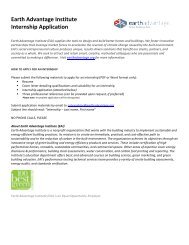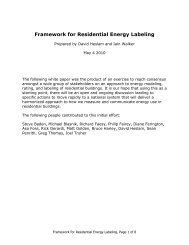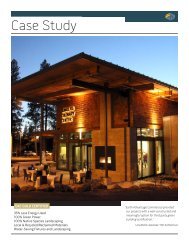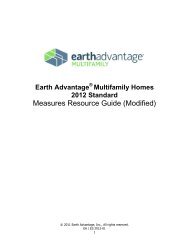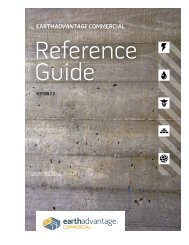EA New Homes Measures Guide - Earth Advantage
EA New Homes Measures Guide - Earth Advantage
EA New Homes Measures Guide - Earth Advantage
You also want an ePaper? Increase the reach of your titles
YUMPU automatically turns print PDFs into web optimized ePapers that Google loves.
2012 <strong>Earth</strong> <strong>Advantage</strong> Residential<br />
<strong>Measures</strong> Resource <strong>Guide</strong><br />
6.1.1<br />
Energy Health Land Materials Water<br />
Efficient Lighting Package: 80 percent of fixtures are fitted with ENERGY<br />
Prerequisite<br />
STAR products<br />
Description: Install ENERGY STAR rated fluorescent lighting products or LED products in 80 percent or more of the lighting fixtures of the<br />
house. These may be dedicated fixtures or standard fixtures with screw-in CFL's or ENERGY STAR LED's.<br />
Benefit: Energy efficient lighting products are readily available. Compared to old-fashioned bulbs, they use less energy and last longer. This<br />
is the simplest way to reduce energy use and save on electric costs. Compact fluorescent lights (CFL's) are available with the same type of<br />
base as an incandescent bulb, so they can be used in all standard light fixtures. A dedicated fixture is hard-wired and uses pin-based bulbs<br />
(GU24). Linear fluorescent tubes come in a variety of sizes T2, T5 and T8, all of which are thinner than the old-fashioned T12 tubes.<br />
Fixtures are good in high use areas (four or more hours of use per day) examples are; kitchen, bathroom, hallway or family room. <br />
<br />
Fluorescent lights use about one-third the energy as incandescent bulbs to produce the same amount of light. Fluorescent lights last<br />
thousands of hours instead of hundreds of hours for incandescent lights. Light-emitting diodes (LED's) are even more efficient and last<br />
even longer than fluorescents.<br />
Verification: <strong>EA</strong> Rater will count the number of installed fixtures to determine if at least 80 percent of the fixtures have been installed with<br />
qualified products. As an alternative, a lighting density calculation can be done to show that total lighting energy use is 0.8 watts per<br />
square foot or less. Ask your <strong>EA</strong> representative for more information.<br />
6.1.2<br />
Lighting Controls: Interior and/or exterior. minimum two lighting zones<br />
Energy<br />
Materials<br />
Water<br />
1 0 0 0 0<br />
Description: Devices that limit or control the operating time and energy use can be installed wherever lighting is needed. <br />
<br />
Sensors can control either interior or exterior lights. Interior motion sensors will automatically sense when an occupant enters or leaves a<br />
room, which minimizes the amount of time the lights are left on in an unoccupied room. Exterior sensors will automatically turn security<br />
lights on when it detects motion. It's not a good idea to control fluorescents with motion sensor. This measure does not include dimmers. <br />
<br />
Points are awarded for each application. One point for one type of installation, with a maximum of two points.<br />
Health<br />
Land<br />
Benefit: Lighting controls reduce energy use by limiting the amount of time lights are burning unnecessarily. Outdoor lights often run the<br />
longest hours and are excellent candidates for lighting controls. Fluorescent lights should not be installed in applications with frequent<br />
cycles and short on times. These applications are best suited to LED's.<br />
Verification: <strong>EA</strong> Rater will count the number of lighting controls or confirm the presence of a home automation system that controls at least<br />
two independent light zones. For example, three pendants over a counter is one zone.<br />
6.2 Appliances<br />
Page 45 of 70



